Related Research Articles

Carnatic music or Karnataka Sangita is a system of music commonly associated with South India, including the modern Indian states of Andhra Pradesh, Karnataka, Kerala, Tamil Nadu and portions of east and south Telangana and southern Odisha.

Indian classical music is the classical music of the Indian subcontinent. It is generally described using terms like Shastriya Sangeet and Marg Sangeet. It has two major traditions: the North Indian classical music known as Hindustani and the South Indian expression known as Carnatic. These traditions were not distinct until about the 15th century. During the period of Mughal rule of the Indian subcontinent, the traditions separated and evolved into distinct forms. Hindustani music emphasizes improvisation and exploration of all aspects of a raga, while Carnatic performances tend to be short composition-based. However, the two systems continue to have more common features than differences. Another unique classical music tradition from the eastern part of India is Odissi music, which has evolved over the last two thousand years.

The tanpura is a long-necked, plucked, four-stringed instrument originating in the Indian subcontinent, found in various forms in Indian music. Visually, the tanpura resembles a simplified sitar or similar lute-like instrument, and is likewise crafted out of a gourd or pumpkin.

The nadaswaram is a double reed wind instrument from South India. It is used as a traditional classical instrument in Tamil Nadu, Andhra Pradesh, Telangana, Karnataka and Kerala and in the northern and eastern parts of Sri Lanka.

A shruti box is a musical instrument, originating from the Indian subcontinent, that traditionally works on a system of bellows. It is similar to a harmonium and is used to provide a drone in a practice session or concert of Indian classical music. It is used as an accompaniment to other instruments and notably the flute. The shruti box is also used in classical singing. In classical singing, the shruti box is used to help tune the voice. The use of the shruti box has widened with the cross-cultural influences of world music and new-age music to provide a drone for many other instruments as well as vocalists and mantra singing.
In music, a drone is a harmonic or monophonic effect or accompaniment where a note or chord is continuously sounded throughout most or all of a piece. A drone may also be any part of a musical instrument used to produce this effect; an archaic term for this is burden such as a "drone [pipe] of a bagpipe", the pedal point in an organ, or the lowest course of a lute. Α burden is also part of a song that is repeated at the end of each stanza, such as the chorus or refrain.

A thavil (Tamil:தவில்) or tavil is a barrel-shaped percussion instrument from Tamil Nadu. It is also widely used in other South Indian states as well as in the North and East of Sri Lanka. It is used in temple, folk and Carnatic music, often accompanying the nadaswaram. The thavil and the nadaswaram are essential components of traditional festivals and ceremonies in South India.

The kanjira, khanjira, khanjiri or ganjira, a South Indian frame drum, is an instrument of the tambourine family. As a folk and bhajan instrument, it has been used in the Indian subcontinent for many centuries.
The venu is one of the ancient transverse flutes of Indian classical music. It is an aerophone typically made from bamboo, that is a side blown wind instrument. It continues to be in use in the South Indian Carnatic music tradition. It is referred to as nadi and tunava in the Rigveda and other Vedic texts of Hinduism. In northern Indian music, a similar flute is called bansuri. In the south, it is also called by various other names such as pullanguḻal (புல்லாங்குழல்) in Tamil, oodakuḻal (ഓടകുഴൽ) or kurungu kuḻal in Malayalam (Kerala) and ಕೊಳಲು (koḷalu) or ಮುರಳಿ (muraļi) in Kannada (Karnataka). It is known as pillana grōvi or vēṇuvu (వేణువు) in Telugu. It is also called as Carnatic Flute.

The Rudra veena —also called Bīn in North India—is a large plucked string instrument used in Hindustani Music, especially dhrupad. It is one of the major types of veena played in Indian classical music, notable for its deep bass resonance.
Swara or svara is an Indian classical music term that connotes simultaneously a breath, a vowel, a note, the sound of a musical note corresponding to its name, and the successive steps of the octave, or saptanka. More comprehensively, it is the ancient Indian concept of the complete dimension of musical pitch. At its most basic comparison to western music, a swara is, essentially, a "note" of a given scale. However, that is but a loose interpretation of the word, as a swara is identified as both a musical note and tone; a "tone" is a precise substitute for sur, relating to "tunefulness". Traditionally, Indian musicians have just seven swaras/notes with short names: sa, re, ga, ma, pa, dha, ni, which they collectively refer to as saptank or saptaka. This is one of the reasons why swara is considered a symbolic expression for the number seven. In another loose comparison to western music, saptak may be interpreted as solfège, e.g. the notes of a scale as Do, Re, Mi, Fa, Sol, La, Ti .Saptak can named as heptave because it contains seven notes.
Delhi P. Sunder Rajan is a violinist-vocalist of India performing South Indian Classical music. He is known for his improvisations and style of playing.

The urumi is a double-headed hourglass drum from the state of Tamil Nadu, South India. Two skin heads are attached to a single hollow, often intricately carved wooden shell. The preferred wood is jackwood, although other woods like rosewood may be used. Both left and right heads are usually made from cow hide that is stretched around a thin metal ring. The outer circumference of each head is perforated with approximately seven to eight holes. The two heads are held in tension by a continuous rope that is woven around the drum in a V-shape pattern. Additional small coils of string or metal are tied around each pair of ropes near the left head. These coils can be slide horizontally along the length of the drum, increasing or decreasing the tension between the heads as necessary. For example, during the monsoon season the drum heads will slacken so much that the instrument becomes unplayable. Using these coils drummers can easily rectify such problems.

A tabla is a pair of hand drums from the Indian subcontinent. Since the 18th century, it has been the principal percussion instrument in Hindustani classical music, where it may be played solo, as an accompaniment with other instruments and vocals, or as a part of larger ensembles. It is frequently played in popular and folk music performances in India, Bangladesh, Afghanistan, Pakistan, Nepal and Sri Lanka. The tabla is an essential instrument in the bhakti devotional traditions of Hinduism and Sikhism, such as during bhajan and kirtan singing. It is one of the main qawwali instruments used by Sufi musicians. The instrument is also featured in dance performances such as Kathak. Tabla is a rhythmic instrument.
The titti is a type of bagpipe played in Andhra Pradesh, India, made from an entire goat-skin. The instrument is described as a goatskin with a double-reed inserted into one leg, and a bamboo blowpipe into the other. The term tittii is used in Telugu, Kannada, and Malayalam.

The sruti upanga is a type of bagpipe played in Tamil Nadu, southern India. The instrument was often used to supply a drone to accompany mukha vina music.
Alankara, also referred to as palta or alankaram, is a concept in Indian classical music and literally means "ornament, decoration". An alankara is any pattern of musical decoration a musician or vocalist creates within or across tones, based on ancient musical theories or driven by personal creative choices, in a progression of svaras. The term alankara is standard in Carnatic music, while the same concept is referred to as palta or alankara in Hindustani music.

The veena, also spelled vina, is any of various chordophone instruments from the Indian subcontinent. Ancient musical instruments evolved into many variations, such as lutes, zithers and arched harps. The many regional designs have different names such as the Rudra veena, the Saraswati veena, the Vichitra veena and others.

Pichu Sambamoorthi (1901–1973) was an Indian musicologist, writer and the professor of musicology at the Sri Venkateswara University, Tirupati. He was the author several books on music, including A Dictionary of South Indian Music and Musicians, Great composers, South Indian Music, Sruthi Vadyas (Drones) and Laya Vadyas: Time-Keeping Instruments. He was awarded the Madras Music Academy's Sangeetha Kalanidhi in 1972. The Government of India awarded him the third highest civilian honour of the Padma Bhushan, in 1971, for his contributions to music. He was also a 1963 recipient of the Sangeet Natak Akademi Fellowship.
References
- ↑ Sampa Ghosh; Utpal Kumar Banerjee (1 January 2006). Indian Puppets. Abhinav Publications. pp. 26–. ISBN 978-81-7017-435-6 . Retrieved 25 December 2012.
- ↑ Shrine to Music Museum (University of South Dakota); Thomas E. Cross (1982). Instruments of Burma, India, Nepal, Thailand, and Tibet. Shrine to Music Museum, University of South Dakota. Retrieved 25 December 2012.
- ↑ Light Isaac (1967). Theory of Indian music. Printed at Shyam Printers. pp. 156–157. Retrieved 25 December 2012.
- ↑ Alison Arnold (2000). South Asia: The Indian Subcontinent. Taylor & Francis. pp. 360–. ISBN 978-0-8240-4946-1 . Retrieved 25 December 2012.
- ↑ Vidya Shankar (1983). The art and science of Carnatic music. Music Academy Madras. p. 10. Retrieved 25 December 2012.
- ↑ Alison Arnold (2000). South Asia: The Indian Subcontinent. Taylor & Francis. pp. 359–. ISBN 978-0-8240-4946-1 . Retrieved 25 December 2012.